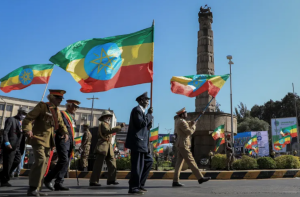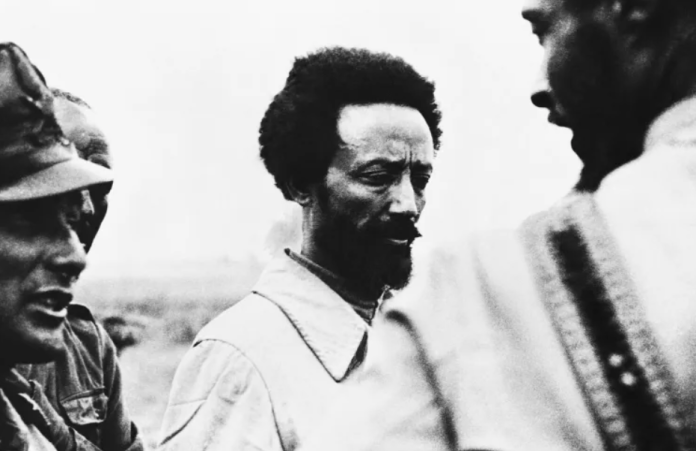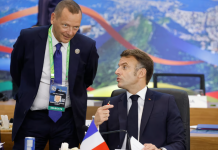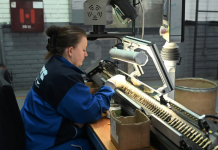Medal Italian colonial soldiers stole from Prince Damtew has resurfaced at auction 87 years after the war hero was executed.
Amaha Kassa’s grandfather was the last remaining commander who bravely rallied troops and fought back when the Italians invaded and briefly colonised Ethiopia in 1935. Four decades earlier, the Italians initially attempted to annex the country but were soundly defeated. This time though, the story would be different.
Armed with rifles and spears, the Ethiopians were no match for the new machineguns the Italians carried, and the aircraft that sprayed deadly chemicals from the sky.
Although Kassa’s grandfather, Ras (Prince) Desta Damtew, fought long and hard, he was eventually caught and executed in 1937. Tens of thousands more Ethiopians would be killed during the seven-year occupation, including civilians and Red Cross aid workers – a memory still raw for many in the country.
So it was with shock and anger that Kassa and his siblings discovered in November that a gold medal Damtew owned was set to be auctioned by an art gallery in Switzerland. The piece was going for between 60,000 and 90,000 euros ($61,800 and $92,700).
Its description or provenance stated blatantly that the medal came from the estate of an Italian soldier who “was present at the capture of the prince”, and painted details of Damtew’s killing.
“They were not in any way attempting to hide the provenance of this item, and were even using the personal circumstances of his death and execution as a selling point,” Kassa, who runs African Communities Together, a New York-based activist organisation, told Al Jazeera.
“I just can’t imagine that this would be a Nazi-era object and that something like this would happen. There’s a way that people have not come to think of African issues as being worthy of respect,” he said.
The case has kickstarted an international quest for the medal to be returned. It also shines a light on a pressing, ongoing conversation across Africa, as governments and individuals from Kenya to Cameroon push for the return of thousands of antiquities looted by colonising Western powers.
In Ethiopia, hoards of artefacts were looted, first by the British, and later, by the Italians. Although the 1947 Paris Peace Treaty required that Italy return all of the art and religious objects stolen during its brief occupation, and pay $25m in reparations within 18 months, that treaty has not fully been enforced.
“The Vatican Library has more than 300 Ethiopian manuscripts, most of which were looted during the occupation,” Alula Pankhurst, the country director of Oxford University’s Young Lives Ethiopia project, told Al Jazeera. While some items have been returned, Italy has continued to hold on to hundreds of other items like crowns, royal regalia, and paintings, said the veteran professor of Ethiopian studies.

Symbol of African resistance
Ras Desta Damtew was executed by the Italian army in February 1937, at age 44. His was a long life of service to the then-Ethiopian Empire. His father died commanding soldiers in the iconic Battle of Adwa in 1896 when Ethiopian forces humiliated Italian invaders in their initial attempt at conquest. It was the first time an invading European power lost to an African force.
Damtew too fought for various monarchs. He helped Emperor Haile Selassie attain the throne and later married Leult (Princess) Tenagnework, the emperor’s eldest child.
“I didn’t grow up with personal memories of him, but I certainly heard a lot about him,” Kassa said, sharing that his mother, Princess Seble – one of the couple’s eight children – was only a child when Damtew died. “He was this kind of legend. There’s a tremendous sense of pride in the sacrifices that he made, but then there’s also a sort of sadness to it as well.”
In old newspaper articles, Damtew is described as stoic, handsome and intelligent, with a mastery of French. Grainy black and white photos show him in full royal regalia: heavily decorated mid-length robes and shiny leather shoes. In one, a star-shaped brooch is pinned on his right chest – likely the Imperial Order of the Star of Ethiopia – a medal of pure gold that signified a rare military honour conferred for service to the crown, and the artefact at the centre of the current uproar.
As a special ambassador of Ethiopia, the prince visited the United States in July 1933 decked in flowing robes and bearing gifts including lion manes and photos of the emperor. He was feted by President Franklin Roosevelt in Washington. Two years later in October 1935, the Italians, under fascist leader Benito Mussolini, invaded and seized Addis Ababa.
With their “deadly rain” of sulfur and machineguns, the 100,000-plus Italian army decimated Ethiopia’s defences, even though the local forces outnumbered the invaders eight to one. To clamp down on a budding civilian resistance, the Italians massacred people in their thousands, while also pillaging Ethiopia’s cultural objects. At least 100,000 Ethiopians were killed by the end of the occupation in 1941.
Damtew’s battalion spent two years holding the fort even as Emperor Selassie fled into exile. By the time the prince was caught, he had been wounded in the fighting. Some accounts say he turned himself in – which would make him a prisoner of war, and his murder, a possible war crime under the Geneva Convention that came into force in 1931.
For many across a continent where calls for independence were getting louder, the prince became a symbol of African resistance. In Ethiopia, Damtew became a hero. One medical college in Addis Ababa bears his name.
After the war, in 1948, Ethiopia wrote to the United Nations War Crime Commission (UNWCC), accusing 10 Italians of being involved in the prince’s killing, and alleging a war crime.
Before November last year, the whereabouts of Damtew’s star-shaped brooch were unknown. It’s unclear if the Italian soldier stole the gold medal from his body when they killed him, or afterwards. What’s clear, the prince’s family said, is that the medal is in the wrong hands and should be sent back to Ethiopia.
“We’re not seeking personal ownership of this piece,” Kassa said. “Our position is that this belongs to an Ethiopian museum. We want to see it restored and on display to the people of Ethiopia because it’s not just our family’s heritage.”
Medal auction ignites a panicked campaign
Only days before the auction, Kassa, his siblings, and their cousins approached lawyer Christopher Marinello, an art recovery expert and founder of Art Recovery International, for help. Marinello has decades of experience dealing with stolen artefacts, from Nazi-looted artworks to stolen Indian artefacts.
“The family came to me saying: ‘We are in a panic’,” Marinello, who is working pro bono, told Al Jazeera. “They wanted to stop the auction, so I took up the case.”
The medal was put up for auction by La Galerie Numismatique, an institution based in Switzerland, on behalf of its current possessor, Philip Bosworth Eagleton, a British art collector based in Spain. However, when Marinello approached the gallery, he was rebuffed. According to email exchanges the lawyer shared publicly, the gallery asked the family to buy the medal instead.
“It’s typical,” Marinello said. “When you tell people they have something that belongs to someone else, they start to think – how can I get my money out of this? Greed really runs these things.”
La Galerie Numismatique did not respond to Al Jazeera’s request for comment.
The auction went live on December 1, 2024. By then, Kassa, and other family members had begun posting about the medal on social media, kickstarting an international campaign to stop the sale. The Ethiopian embassy in Switzerland wrote to the gallery to stop the bid. Although the auction proceeded, the medal eventually failed to receive the minimum bid of 60,000 euros, meaning it remains unsold.
Marinello said he is now negotiating with Eagleton to retrieve the medal.
In a statement to Al Jazeera, Eagleton said he was willing to cooperate but claimed that the medal’s history was more complicated than is believed to be the case. He’d bought the piece five years ago and had not paid much attention to its originality, he said. Following December’s campaign by the family, Eagleton said he consulted an expert and found that the piece was made only 10 years ago.
“Due to the drama over this, it’s not something I wish to hold onto as it begins to smell like a dead horse in the tropic,” the collector said. “[But] it would be tragic to convey a known debunked ‘fake’ to the esteemed family who have suffered enough from their grandfather’s death.”
Eagleton would have had to approve the medal’s description as an original before it went up for auction. The collector confirmed that he did sign off on the published provenance, but added that he “didn’t pay too much attention” to the description until now.
So much lost, one thing found?
When he was just a toddler, Amaha Kassa and his two sisters were forced to flee Ethiopia for the United States in 1977.
The monarchy of Emperor Selassie had fallen, this time in a bloody revolution by the military, in an attempt to establish a socialist state. Kassa’s mother was captured and would be imprisoned for more than a decade by the communist military government, or Derg. Their father, a government minister, was one of several empire officers executed after the coup.
“Our family lost everything in the revolution,” Laly Kassa, Amaha’s sister, said in an interview with Ethiopia Broadcasting Corporation in January. “Everything our parents or grandparents owned was lost … Our mother and aunts were not likely thinking about this medal, we were counting lives, not belongings.”
Now that something of their grandfather’s has surfaced, the family says they are unwilling to let it go and are undaunted by claims that the medal could be a fake.
“We don’t want to believe that the auctioneers were trying to commit fraud by listing it as the real thing,” Kassa said. “We really don’t want to think they are lying.”
Indeed, some observers note that the medal listed for auction differs slightly from the typical Order of the Star brooch Ras Damtew wore. In the original, it is believed that there are five mini crosses in the design, but in the listed item, there are gold discs where those crosses would have been.
The medal “was deliberately defaced to hide the five crosses on it presumably to hide its origins,” said Pankhurst, the professor of Ethiopian history. Kassa and his family are working with Ethiopia’s archive authorities to confirm if the medal is real, he added.
Gregory Copley, the Strategic Adviser to the Crown Council of Ethiopia, the organisation in charge of former empire affairs, told Al Jazeera they have seen several items originally belonging to Ethiopian officials traded for large amounts, despite proof that they were illegally acquired.
Regarding this medal, he said if it is solid gold, it could likely have been given to Damtew by the Emperor himself – as other breast stars given to officers were merely gold-plated. But he added that a photograph alone was insufficient to determine ownership.
“On the basis of this limited information, however, we would definitely say that the probability of the breast star being illegally obtained is extremely high,” Copley added.
Ultimately, Kassa said, the family does not plan to back down on the fight and is moving forward believing the listed medal is their grandfather’s property.
“I think that after all the sacrifices that my grandfather made, the least we can do is to try to see this piece of history restored to Ethiopia,” Kassa said. It’s not just a fight for their family heritage, he added, but for the heritage of the Ethiopian people.






















